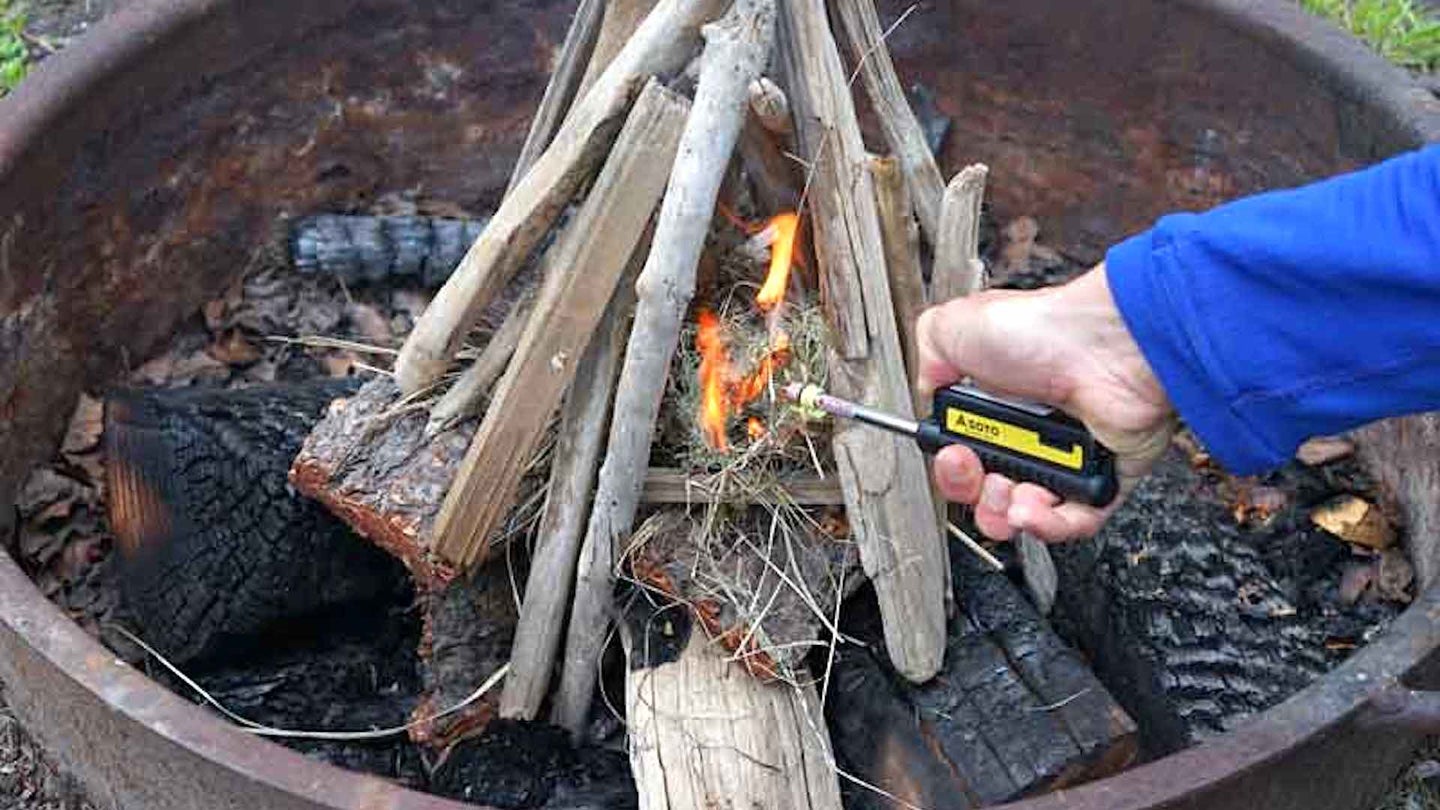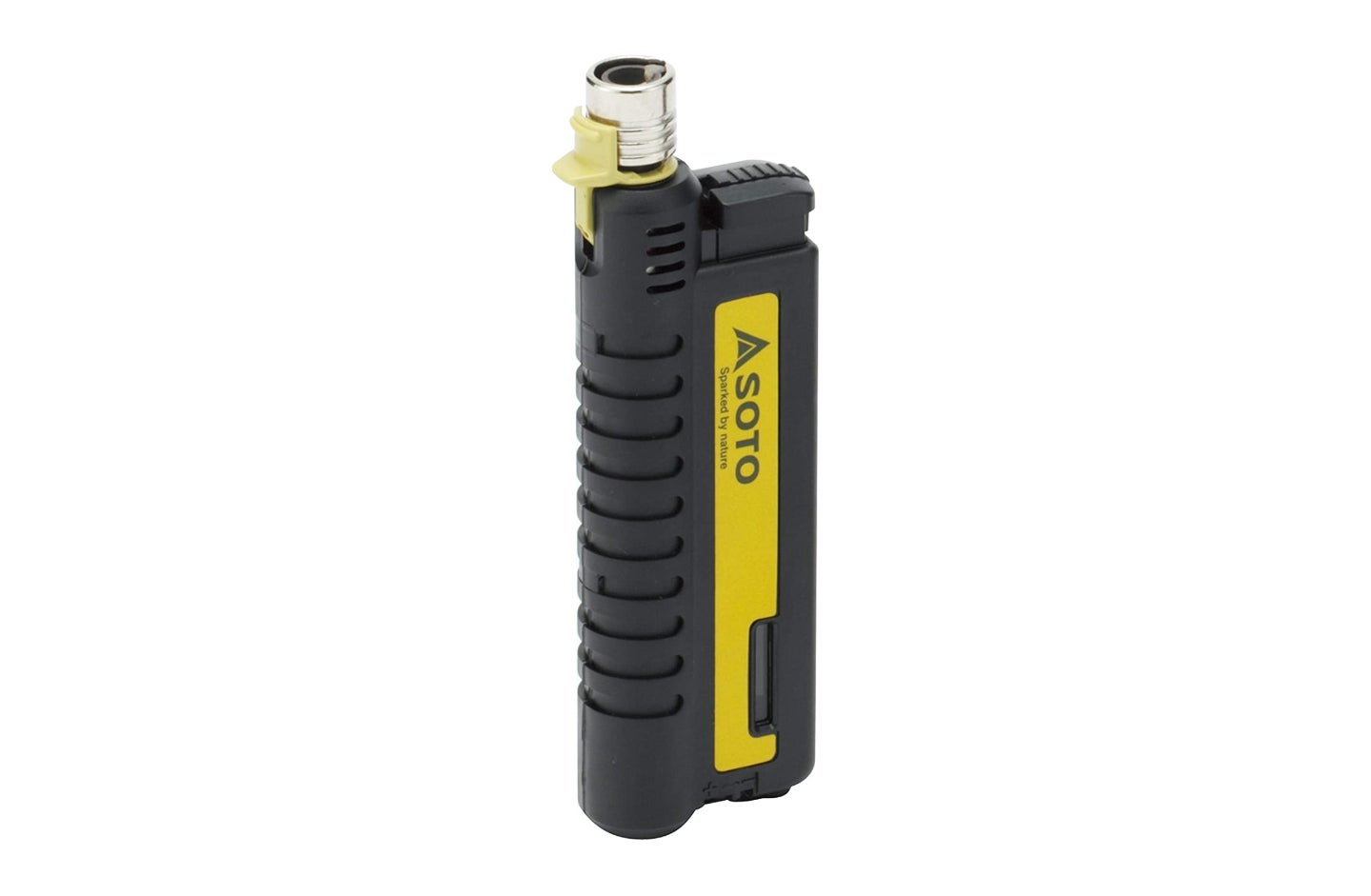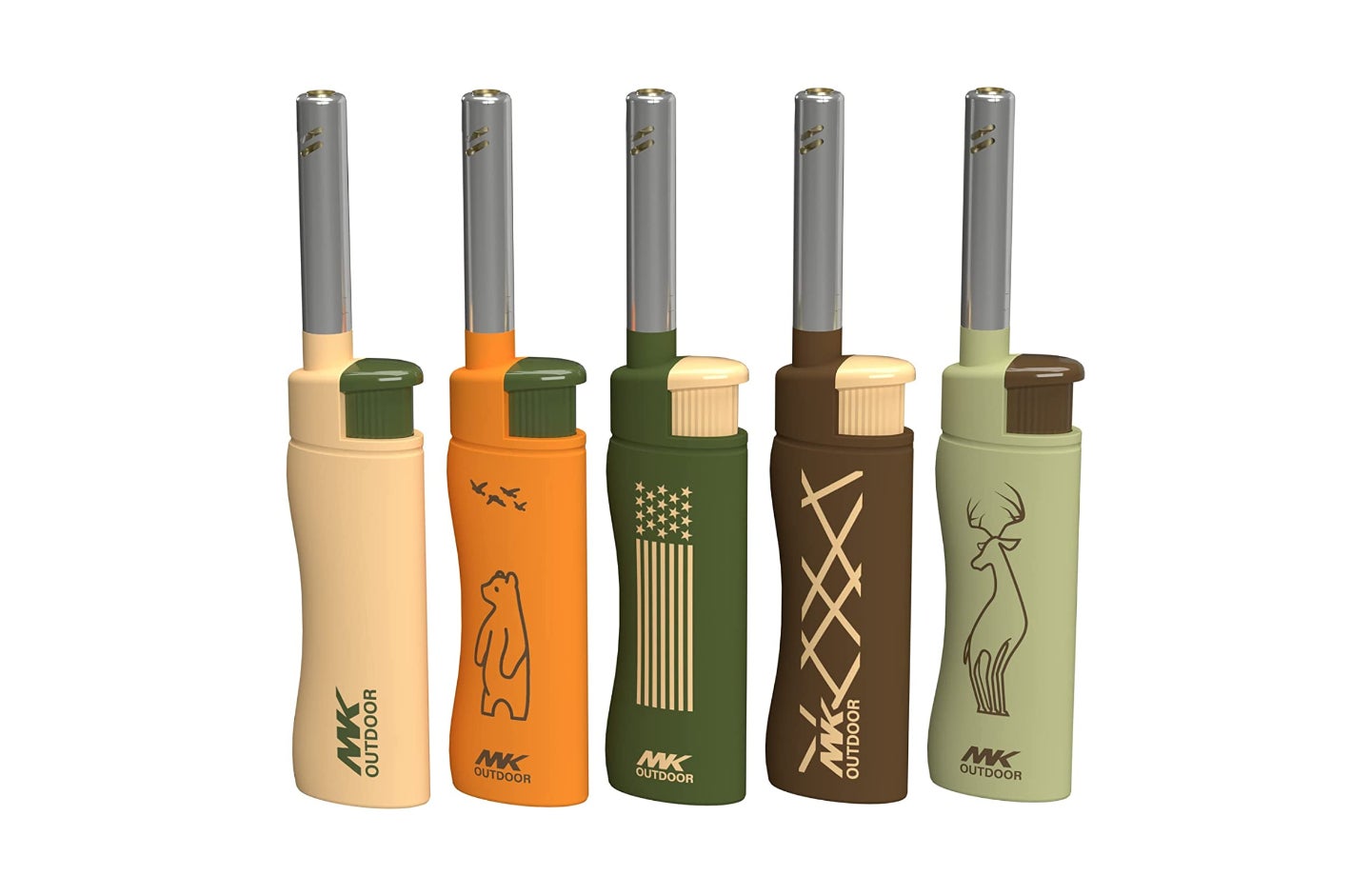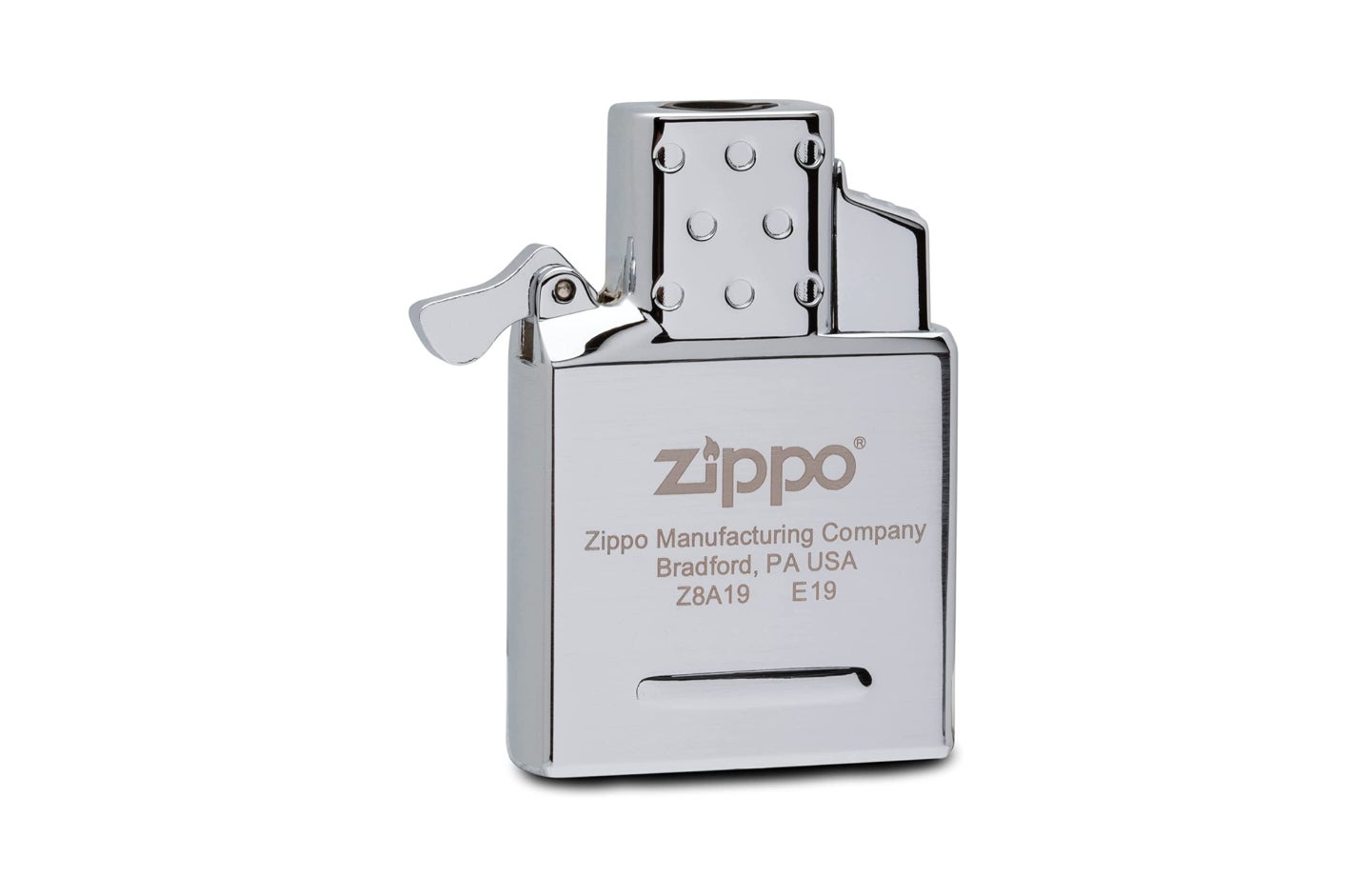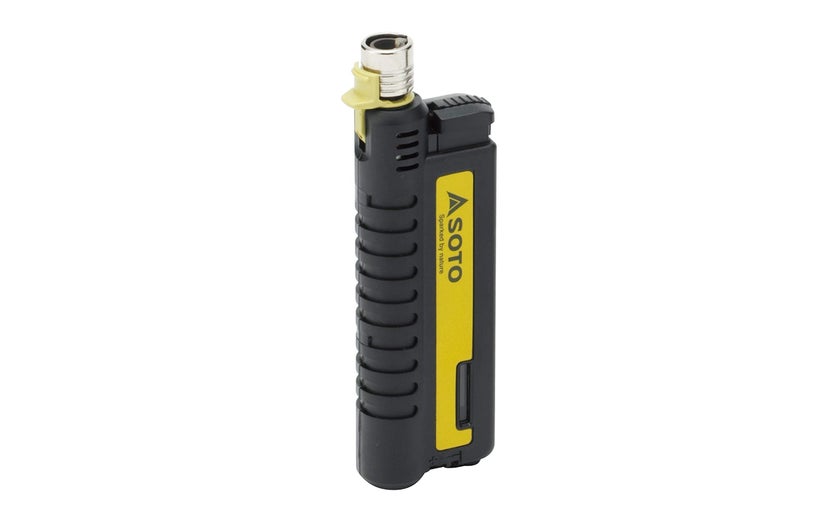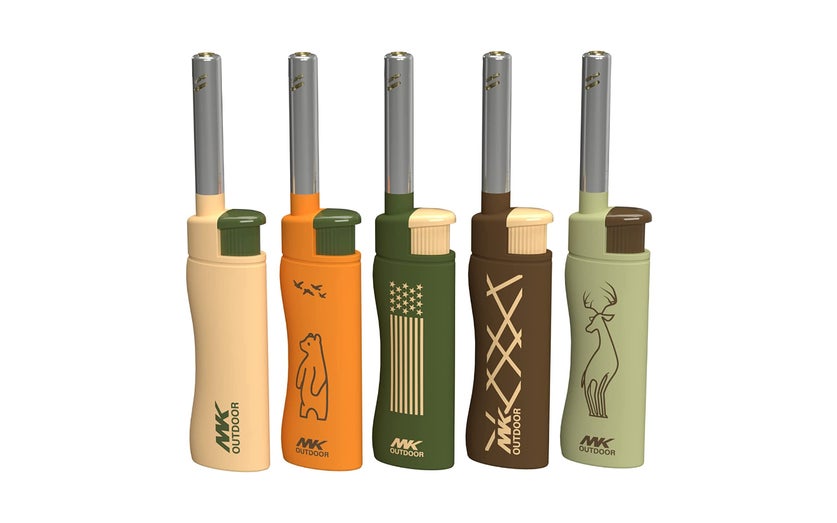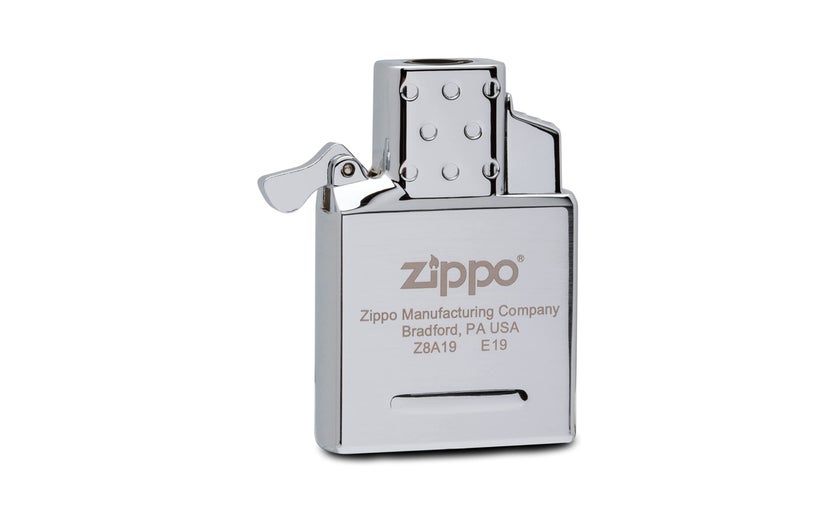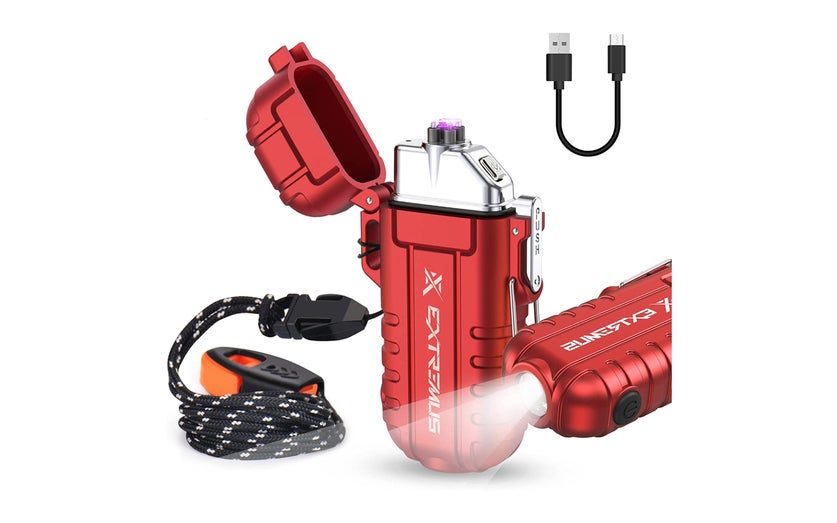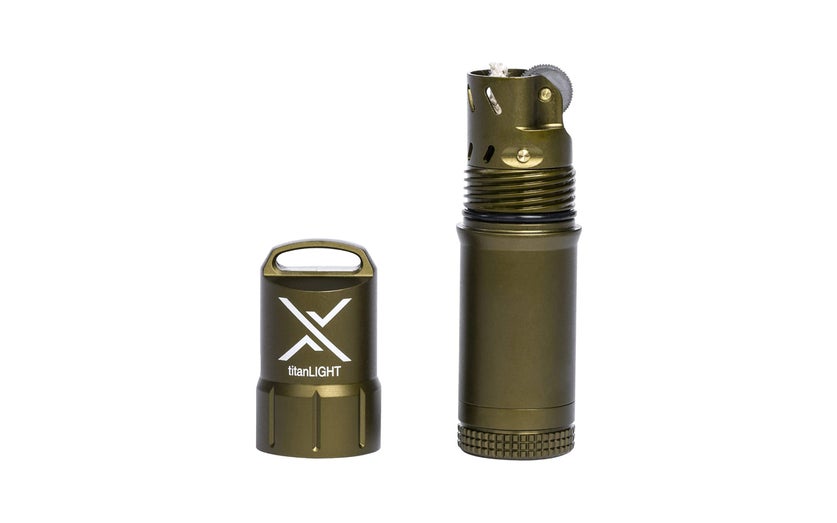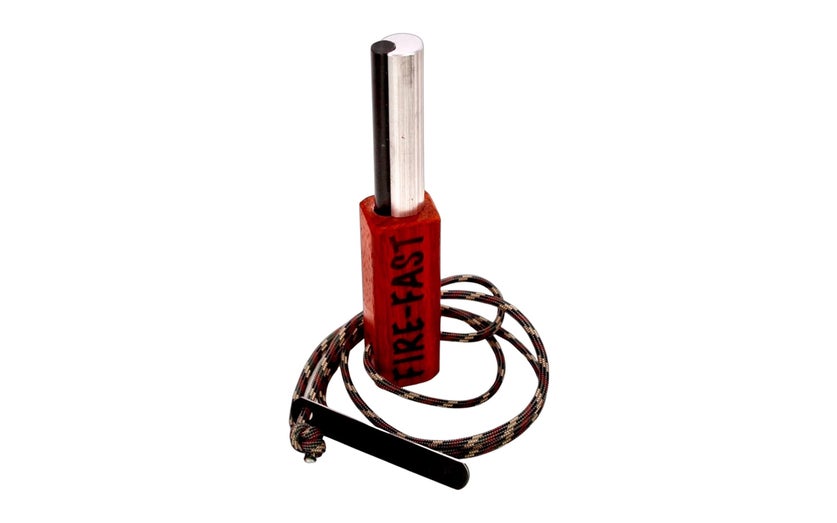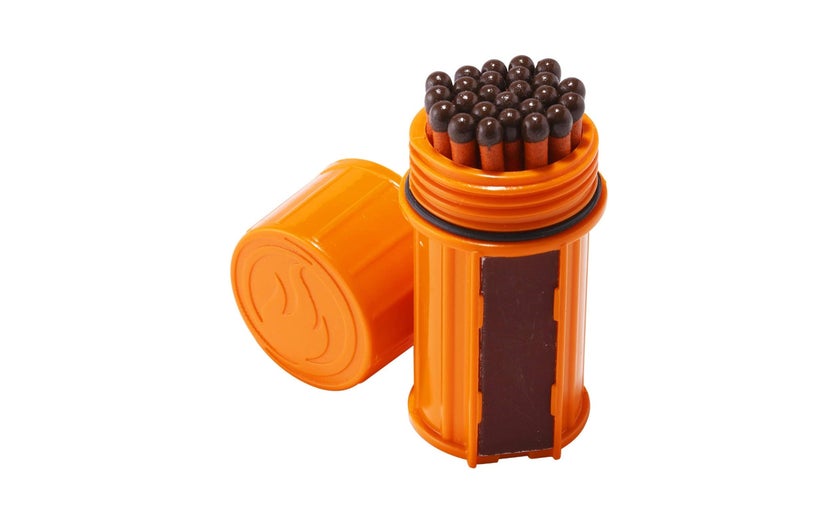We may earn revenue from the products available on this page and participate in affiliate programs.
With so many fire-starting options, it can be tough to know which are the best camping lighters and for what. From the ubiquitous Bic and Zippo to more niche tools like ferrocerium (ferro) rods, magnesium, and mini torches, there’s a plethora of methods for starting something on fire. While the options are numerous, to increase your chances of fire-making success, it’s important to match the lighter to the fire-starting application it excels at.
Whether you’re camping in the backyard or backwoods, there’s a lighter to fit your needs, and we’ve put in the testing and research elbow grease so you don’t have to. Read on to find our picks for the best camping lighters.
- Best Overall: Soto Pocket Torch XT
- Best Value: MK Lighter Outdoor Series Lantern
- Honorable Mention: Zippo Butane Lighter Insert-Single Torch
- Best Plasma: Extremus Blaze 360 Windproof Lighter
- Most Reliable: Exotac titanLIGHT
- Best Magnesium/Ferrocerium Combo: Fire Fast Kamper Lanyard
- Best Stormproof Matches: UCO Stormproof Match Kit
Based in Japan, Soto has been making “innovative flaming devices” since 1978 and is well-regarded for its camping stoves and other camping gear. With its Pocket Torch XT, the company checks nearly all of the boxes for a perfect camping lighter. Reliability was my number one criterion when rating the lighters in this article. If they didn’t light every time they were activated, they didn’t make the cut. Owing to its excellent build quality, this butane torch lighter fires up very reliably, and I can confidently say it is an all-weather lighter.
While initially skeptical of the telescoping burner head, I did extensive research of primary sources with hands-on experience with this lighter, and the telescoping head is actually rugged and well-made. When building a fire, the tinder is placed in the center, and larger pieces of wood are arranged around the outside. Without a long neck lighter, you have to awkwardly reach into the construction to light the tinder, but the neck is always awkward and doesn’t travel well. The ability to collapse the neck back into the lighter is innovative and actually extremely useful. Due to the long telescoping neck, this is an excellent lighter for campfires. Priced at around $25, this camping lighter combines quality and value.
While butane jet lighters with piezo ignition aren’t generally considered the most reliable category of lighter, the Pocket Torch XT still wins the top spot due to its uncommonly excellent build quality and reliable ignition.
- Lighter type: Butane jet
- Ignition type: Piezo-electric
- Windproof: Up to 80mph
- Water-resistant: Flame will withstand fog or very light mist
- Refillable: Yes
- Adjustable flame: No
- Special features: Innovative, rugged, telescoping burner head
- With a refillable butane reservoir, quality construction, and an innovative telescoping flame head, the Soto Pocket Torch XT checks almost all of the boxes for a compact camping lighter
Windproof butane jet flame is reliable in adverse conditions
Innovative telescoping burner head keeps hands away from the flame
Made by Soto, a well-regarded manufacturer of camp stoves
Excellent customer service
May not light in extreme cold or above 5,000-foot elevation
Slightly bulky, may not be comfortable in a front pants pocket
Could be better ruggedized, and piezo ignition is generally not the most reliable style of lighter ignition
Since 2011, the California-based MK Lighter has been making top-notch affordable lighters. With that said, the MK Lighter Outdoor Series Lantern is the most reliable and earns the award for the best budget lighter.
While the Outdoor Series Lantern looks like a Bic and is just as simple to operate, it has what a Bic doesn’t: a torch-style windproof flame. Every single time I click the piezo switch on MK’s Lantern (or Navigator), it spits out a nice blue, pressurized flame.
The MK lighter would’ve made the top spot if it wasn’t for two things. First, it has a small butane reservoir despite its long neck, and second, it has a relatively lightweight construction. While MK has a beefier model — the Hawk — it’s a utility torch and not a camping lighter.
MK’s outdoor series of lighters spans several models and features really nice color and image themes that give a nice camping vibe.
- Lighter type: Butane jet
- Ignition type: Piezo-electric
- Windproof: Yes
- Water-resistant: Flame will withstand fog or very light mist
- Refillable: Yes
- Adjustable flame: No
- Special features: Extended, fixed burner head
- This outdoor-themed butane camping lighter is refillable with a windproof flame, reliable piezo ignition, and an extended neck, at a great price.
Incredible value for the money
MK is gaining a reputation for innovative, value-priced lighters
Windproof butane jet flame is reliable in adverse conditions
Appealing outdoor-themed designs
May not light in extreme cold or above 5,000-foot elevation
Smaller reservoir will need more frequent refilling
Not ruggedized
If there’s a “best lighter for X” list, Zippo is probably on it. Renowned for American-made quality, history, and nostalgia, Zippos are an icon in the lighter world. With its butane lighter inserts, Zippo has taken its already “wind-proof” lighters to the next level. While excellent lighters, setting a camp fire ablaze with a traditional Zippo is not ideal due to the engineering of the “chimney,” or flame area. The butane jet inserts improve campfire lighting efficacy by projecting the flame out enough to keep your fingers away from the inferno. The Zippo inserts boast a feature not found on the other butane jet lighters in this review: an adjustable flame, which is always a nice addition for when you’re lighting a candle instead of a campfire. This is a small lighter by most standards, making it an attractive option for backpackers. Maybe the best feature of these inserts, though, is you can put them right inside of your favorite Zippo shell, so you can start that marshmallow-roasting fire in style.
Not even Zippo has the perfect lighter, though. The insert retails for around $15, and while it can be used alone, it should be put in a standard-sized Zippo shell, which costs extra. The small butane reservoir is only good for 50 10-second lights between fills, and even though it’s an improvement over the traditional design, the Zippo architecture doesn’t allow for the burner head to be on an extended neck for maximum fire-starting efficacy.
- Lighter type: Butane jet
- Ignition type: Piezo-electric
- Windproof: Up to 80mph
- Water-resistance: Flame will withstand fog or very light mist
- Refillable: Yes
- Adjustable flame: Yes
- Special features: Zippo quality in a butane jet lighter
- With more than 80 years of American-made history, Zippo is instantly recognizable. This butane jet insert takes any standard-sized Zippo to the next level of wind resistance.
Windproof butane jet flame is reliable in adverse conditions
Adjustable flame
Butane jet insert will fit any standard-sized Zippo lighter shell
“It works or we fix it free” warranty
Relatively rugged design
May not light in extreme cold or above 5,000-foot elevation
Insert can be used alone, but should be put inside a Zippo shell
Smallish butane reservoir provides only 50 10-second lights between fills
The Extremus Blaze 360 electric arc lighter has a lot to offer. It boasts an impressive IPX7 waterproof rating and has a rugged case with a locking lid, and an LED flashlight at the base. Personally, I can never have enough sources of light handy when I’m in the woods, so a reliable LED on my lighter is a significant perk.
The electric (or “plasma”) arc is completely windproof, and while Extremus doesn’t specify the duration of each use, it advertises up to 300 ignitions per charge. Even if each ignition is only three seconds, that works out to at least 150 more useful six-second ignitions. Due to its durability, this would be an excellent lighter for backpacking. The lighter also comes with a paracord lanyard and survival whistle. Lastly, there are several color options, ranging from higher-vis neon pink and orange, to more subdued green camo or black.
While electric arc lighters have a lot going for them, they are much less versatile than a combustion/flame lighter. Trying to light a pipe or larger cigar is futile, and arc lighters are not ideal for lighting camp stoves or campfires because the business end has to be in actual physical contact with the fuel, making the job awkward and increasing the potential for burns to your decidedly non fire-resistant digits.
- Lighter type: Electric/plasma/arc
- Ignition type: Piezo-electric switch
- Windproof: Entirely windproof
- Water-resistant: Arc will withstand fog or very light mist
- Refillable: Yes (rechargeable)
- Adjustable arc: No
- Special features: IPX7 waterproof design and LED flashlight
- With a rugged, IPX7 waterproof design, 300 ignitions per charge, and an LED flashlight, this electric lighter boasts several features at a good price.
Completely windproof electric arc
Up to 300 ignitions per charge
IPX 7 waterproof design
Three-mode LED flashlight
Electric arc is not nearly as versatile as a combustion flame
No extended neck limits usage for camp stoves, candles, etc.
The Exotac titanLIGHT is the most reliable lighter because it’s a simple, rugged, utterly dependable piece of fire-starting equipment. With the titanLIGHT, Exotac solves the 100-year-old problem with the fluid-wick-striker design, making it rugged and evaporation-proof enough for a true wilderness lighter.
The body is basically a high-quality, well-engineered O-ring sealed tubular canister that houses a lighter fluid reservoir, flint, striker, and wick. The flint and wick are replaceable, and the unit is easily refilled with lighter fluid. There really is no apparent failure point to this lighter, unlike a piezo-ignited jet lighter (several delicate mechanical potential failure points).
However, I would not consider this lighter a Zippo replacement. It is both hefty and bulky, so you wouldn’t want to carry it in a pants pocket, and the price point (around $70) is more than many campers will be willing to shell out, even for an American-made piece of equipment.
Lastly, the chimney combustion area design is not ideal for lighting a campfire due to the flame dynamics. That said, where utter reliability in an austere environment or very long backpacking trip is your number one concern, this is your lighter.
- Lighter type: Wick
- Ignition type: Flint with wheel striker
- Windproof: Moderately, uses “chimney” design
- Water-resistant: Flame will withstand fog/damp conditions
- Refillable: Yes
- Adjustable flame: No
- Special features: Waterproof, crush-resistant, O-ring sealed canister design limits lighter fluid evaporation
- Ridiculously rugged and utterly dependable, the Exotac titanLIGHT is a sure-fire ignition source for your next adventure.
Extremely durable, waterproof, O-ring sealed canister design
Flint striker and wick design is more dependable than piezo jet lighters
Unlike many traditional lighter fluid designs, titanLIGHT limits fluid evaporation
Designed and manufactured in the United States
Relatively expensive for a camping lighter
Slightly bulky, may not be comfortable in a pants pocket
If you’ve ever tried using a low-quality ferro rod or magnesium, then you know frustration. The Fire Fast Kamper Lanyard is neither cheap nor frustrating. Fire Fast started out as a small mom-and-pop operation in California, bent on delivering the very finest Made-in-America fire-starting tool possible, and it’s done just that.
The magnesium is high-quality, not the super-hard-to-scrape el-cheapo unit you can get at most department store camping sections. The ferro rod is sourced from Austria, which makes the highest quality available (there are no U.S. manufacturers of ferro rods). The wooden handle is high-resin, and can be scraped for kindling in a pinch. The striker is hardened, sharpened steel to prevent dulling and to guarantee a consistent shower of sparks with each strike. The entire tool is completely waterproof, and only gale-force winds would be able to divert the sparks from your campfire.
While an excellent fire-starting device, no ferro rod or magnesium tool is meant to start anything but camp fires. Trying to start a cigar or pipe with magnesium and a shower of sparks seems like an express ticket to your nearest ER or burn unit. The Kamper Lanyard model is moderately bulky and I wouldn’t want it in my pants pocket, and although a smaller size is available, the shorter the ferro rod, the harder it is to get a good spark shower.
- Lighter type: Magnesium/ferrocerium combo
- Ignition type: Flint with blade striker
- Windproof: Yes
- Water-resistant: Yes
- Refillable: No
- Adjustable flame: N/A
- Special features: Made in America with the highest-quality ferrocerium and magnesium available
- There are lots of ferrocerium rods out there, and even several ferro/magnesium combos, but none can touch the quality and thoughtful design of this made-in-America fire starter.
Highest-quality Austrian ferrocerium rod, 8 millimeter x 2.5 inches
Generous portion of quality magnesium, 0.5 inch x 2.5 inch rod
Hardened and sharpened steel striker
Hardwood, high-resin handle for tinder if needed
Meant only for starting campfires; not for cigars, pipes, etc
Somewhat bulky, but smaller sizes available
Unit is not refillable; if ferro rod or magnesium are used up, you must buy a new unit
When you need a firestarter that will burn when wet — even while submerged — these UCO Stormproof Matches are the best answer. Each match has a ferrocerium tip for striking, and a generous coat of flammable compound that is self-oxidizing (this is how it burns underwater) and which burns at a controlled rate, providing up to 15 seconds of flame per match. While these matches can be used to light anything (camp stove, pipe, cigar, camp fire), they excel at starting a campfire in damp conditions. Granted, no fire will start without dry tinder and dryish wood, but if everything else is wet including your fire-starting kit, these matches could be your salvation. Having experimented with these matches extensively, I can comfortably say that they live up to UCO’s claims of water and wind resistance.
The trait that makes these matches great, also makes them potentially hazardous — they’re difficult to put out once lit, which is not a good thing if you accidentally start the whole container ablaze. As the coating is self-oxidizing, the matches can’t reliably be smothered. Lastly, the sturdy waterproof case, while handy, is also bulky and not for pocket carry
- Lighter type: Stormproof matches
- Ignition type: Ferrocerium tip with striker strip
- Windproof: Yes
- Water-resistant: Yes
- Refillable: No
- Adjustable flame: N/A
- Special features: These matches will either burn underwater, or if they do go out, can be re-lit after being submerged
- No fire-starting kit would be truly complete without quality stormproof matches, and the UCO Stormproof Match Kit is the best on the market, offering exceptional value for the price.
Up to 15-second burn time per match, up to six minutes per kit
Completely wind- and water-proof, can burn underwater, re-light after getting wet
Waterproof case holds up to 40 matches
Matches are long enough to reach into campfires, camp stoves
Difficult to put out once lit
Waterproof storage case is bulky, not for pocket carry
Things to consider before buying a camping lighter
Lighter type
Butane jet
A butane jet lighter works via pressurized butane that’s released with a mechanical valve when you press the trigger. Simultaneously, an ignition source is activated, lighting the released butane. The flame from a butane jet lighter is considered windproof and extends straight from the lighter regardless of lighter orientation. This is the most versatile, but not the most dependable, fire-starting lighter.
Non-jet (yellow flame)
A non-jet (or yellow flame) lighter also uses pressurized butane, but the flame is not windproof and will always try to point toward the sky regardless of lighter orientation. It’s more reliable than, but not as versatile as, a butane jet lighter.
Wick
Think Zippo-style. Wick lighters have a non-pressurized lighter fluid reservoir, and most use a chimney-style protective screen around the wick to increase wind resistance. It’s extremely reliable, but the flame is always sky-seeking.
Electric/plasma/arc
No matter what you call it — electric, plasma, or arc — they are all the same thing. All are battery-powered, and produce electricity at sufficient voltage to jump, or arc, across a gap. The arc is very hot and can ignite most material. They are completely windproof, but not practical for lighting larger items.
Ferrocerium rod
Plus or minus magnesium. Ferrocerium, or ferro for short, is a man-made metal alloy that sparks when struck with metal. When paired with magnesium metal shavings, which burn quickly and with extreme heat, they make an extremely weatherproof and utterly dependable fire starting combo.
Stormproof matches
Heavy-duty matches have a self-oxidizing coating that burns at a constant rate. They are very difficult to extinguish once lit.
Ignition type
Peizo-electric
Peizo-electric is a type of metal that, when flexed, produces enough electric current to make a spark. No batteries are required, but it’s not the most reliable ignition method.
Flint and striker
This is usually a ferrocerium flint paired with a wheel-shaped striker (think: Zippo), a sharpened metal striker (ferro rod), or in the case of a match, a strip of striker material. This is an extremely durable and reliable ignition method.
FAQs about camping lighters
Q: What is the most reliable lighter?
A: Most lighter types — flint-and-wick style, ferro rods with magnesium, and stormproof matches — are all extremely reliable fire starters. Butane lighters, especially those ignited with a piezo spark, have several potential mechanical failure points.
Q: What’s better for camping, matches or lighters?
A: They’re very different. While I wouldn’t recommend taking some generic kitchen matches on your next adventure, stormproof matches are very reliable. If you are going on a long backpacking trip, you’ll certainly run out of matches before you’re through and, therefore, should have a dependable lighter on hand, as well.
Q: What is the best windproof camping lighter?
A: If wind resistance is your number one consideration, then an arc/plasma/electric lighter is the answer. The arc generated by these lighters is almost impossible to extinguish with the wind.
Final thoughts
Owing to its uncommonly excellent build quality and dependability for a butane jet lighter, its innovative telescoping burner head, and its unmatched versatility, the Soto Pocket Torch XT takes home the best overall camping lighter.
Methodology
To find the best camping lighters, I relied on personal experience using a variety of lighters in a variety of conditions, as well as recommendations by experts and outdoorsmen published on a number of other websites. I compiled a list of all the “best” ones mentioned and their specific award categories. Next, I tested all of the lighters I had on hand to authenticate manufacturer claims. If I didn’t have a sample, I sourced industry expert opinions who did have first-hand knowledge. For more information on our standards and process, check out the Task & Purpose review guidelines.
